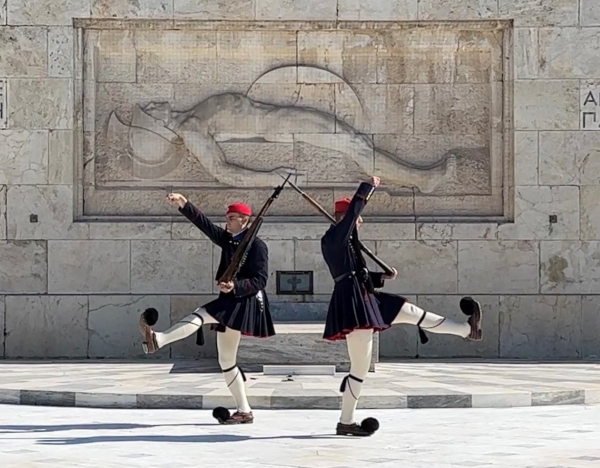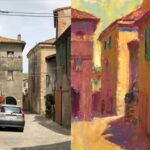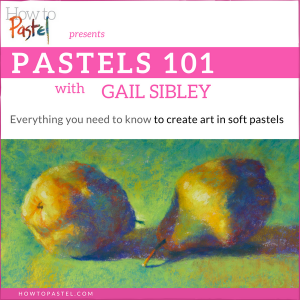After teaching in Corfu recently, I took a few days to explore Athens — a city layered with history and symbolism wherever you turn. On our last morning, Cameron and I found ourselves at Syntagma Square, watching the changing of the guard at the Monument to the Unknown Soldier. The Evzones were in their dark winter uniforms — heavy wool in deep navy — and moved in perfect rhythm.
Even in that sombre palette, there was such beauty. The crisp geometry of movement, the deliberate and stylized choreography, the silent unwavering dignity — it was hypnotic! I watched the guards lift and unfurl each leg high, hold the pose, tip the toe, and lower it with a powerful thud that echoed across the marble square.
I was fascinated by the ritual and dignified grandeur of it all and I couldn’t help wondering: why these exact steps? I couldn’t shake the feeling that there was something behind them. Why such a specific sequence? Why that pause, that lift, that emphatic stomp?

The Story Behind the Steps
As it turns out, every detail of the Evzones’ march is rich with symbolism — a living expression of meaning in art, translated into motion.
- The fustanella (the pleated skirt of the summer uniform) contains 400 pleats, representing 400 years of Ottoman occupation — a tribute to endurance and freedom.
- The deliberate leg lift and emphatic stomp are said to awaken the souls of fallen heroes and proclaim the nation’s continued strength. I was also told by the corporal who “protected” the still and silent standing guards from tourists, that the rising leg created the number 4, another representation of the 400 years of Ottoman rule and that the tipping toe was a reminder of the knife that was often hidden there to be used in fighting.
- Even the uniform’s colours carry meaning: red on the fario cap for the blood shed for the fighters during the Greek War of Independence, the long black tassel symbolizes the tears cried and the mourning for those who sacrificed their lives for freedom, and white for purity of the Greek struggles and peace.
Beauty and meaning are interwoven; the grace and precision of the movement are inseparable from the story it tells. And yet…


Beauty and Meaning Can Coexist
Watching the ceremony, I thought of my students and how often I hear, “I just want to paint something beautiful.” And that’s perfectly valid — beauty alone is reason enough to create.
But here’s what that morning in front of the Hellenic Parliament reminded me: just because something is beautiful doesn’t mean it has to lack meaning. Beauty and symbolism can coexist, enriching one another. The Evzones’ march is visually captivating on its own, but when you understand its history and meaning, it becomes something deeper — beauty carrying memory, pride, and resilience. You feel it — right in your heart.
The same is true of art. A painting may first draw the eye with colour and form, yet quietly hold something more beneath its surface — a thought, a feeling, a personal connection that isn’t immediately visible but can be felt. That’s the essence of meaning in art: the invisible thread between beauty and perhaps a deeper intent.

Three paintings I did in response to the murder of George Floyd. St Michael is the patron saint of police so I imagined how he would respond to the event. My intention was to create beautiful paintings that had this deeper meaning.
When Viewers Bring Their Own Meaning
And sometimes, of course, meaning in art isn’t something we consciously build in at all. We might simply respond to light, shape, colour, or atmosphere — capturing what moved us in that moment. Yet viewers bring their own experiences, memories, beliefs, and emotions to what they see. They may find a message or mood that we never intended. That, too, is a kind of magic — meaning that arises in the space between artist and viewer. And in this way, viewers layer meaning on a piece, deepening its impact. (Check out a blog post I did interpreting Michele Ashby’s painting Tied.)
An Invitation to Reflect
So here’s a little studio musing for you:
When you create something beautiful, could you also imagine a quiet layer of meaning — something subtle, perhaps personal, that deepens the work for those who take time to look?
Or, have you ever found a viewer seeing their story in one of your pieces — a meaning you didn’t plan but were delighted to discover? This has happened frequently with my own work.
I’d love to hear your thoughts. Drop a note in the comments and let’s talk about where beauty and meaning meet in your art.
Until next time,
~ Gail
PS. Here are two examples on YouTube that give you a good sense of the Evzones marching. (They give a bit of differing info and the music can be a bit annoying but the march is there!)




























2 thoughts on “Meaning in Art – When Beauty Carries a Deeper Story ”
I did a pastel of a gnarled old willow tree overhanging a stream and titled it “The Survivor” a customer purchased it for her husband who was fighting prostate cancer. They loved the painting, but title had great meaning for them too.
Oh yes! Such a great example of a deeper meaning in a piece of art. I love how it resonated with the buyer and what it meant to them. Thanks Felicity!